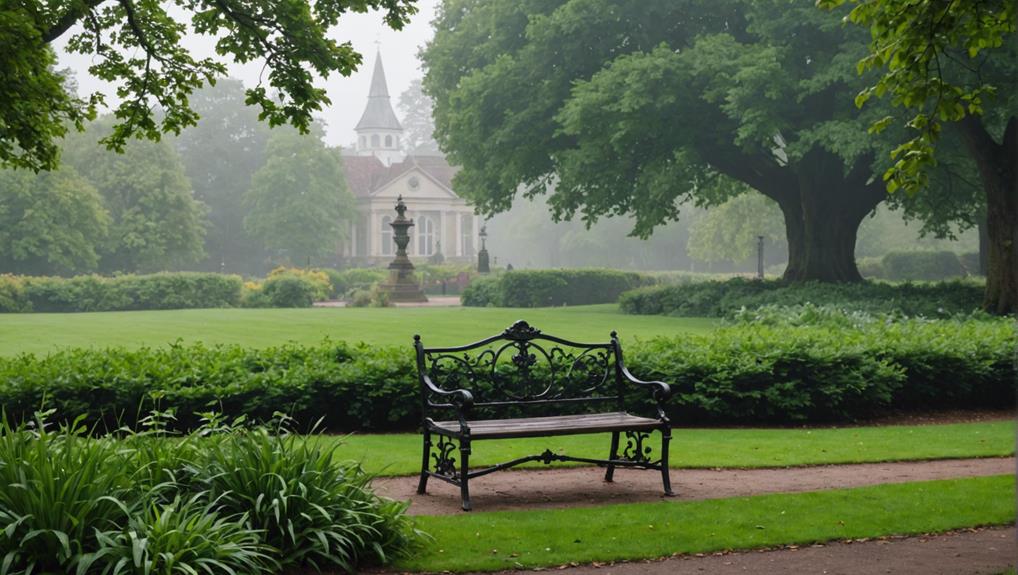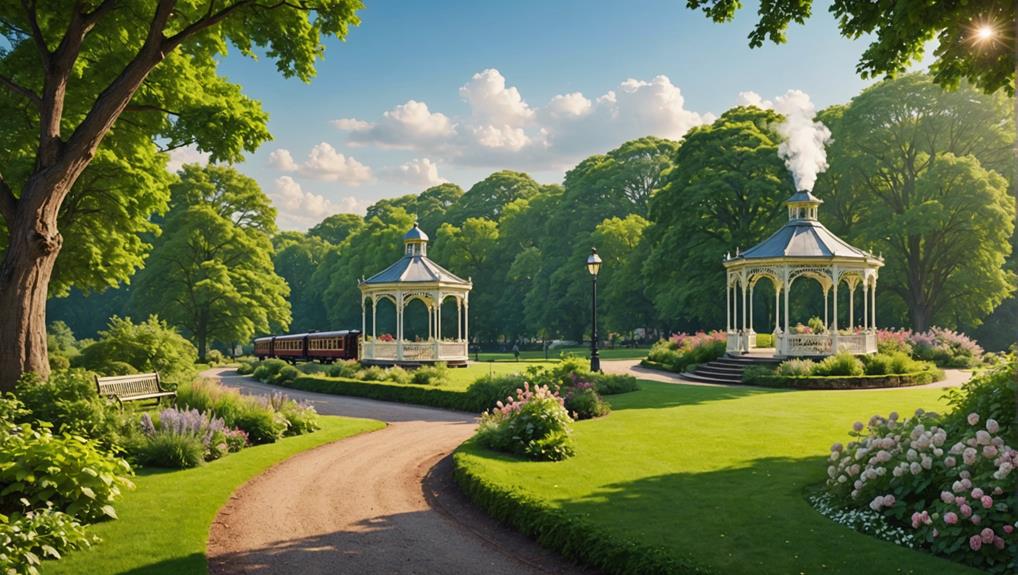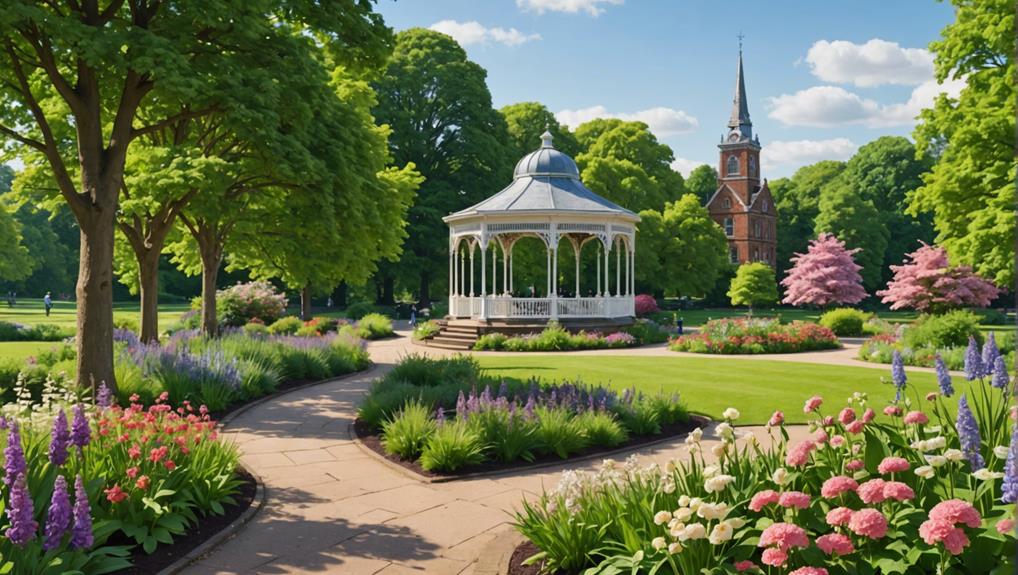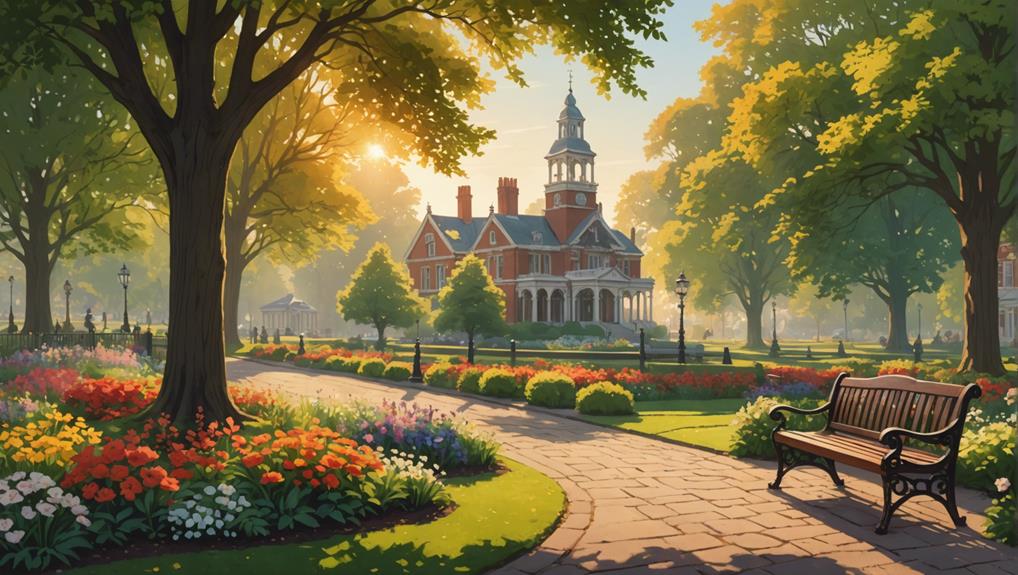Discover how Luton’s community adapts to road closures and infrastructure upgrades, turning short-term disruption into long-term sustainability and resilience. Learn more now!
As you step into Bedford's Victorian Park, you begin a journey through the late 19th century, surrounded by the pioneering garden suburb's blend of traditional and modern architecture, which not only shaped the region's character but also left an indelible mark on subsequent developments like Hampstead Garden Suburb. Discover how architect Richard Norman Shaw's vision influenced the park's design, and how literary figures like Nathaniel Hawthorne contributed to its rich cultural heritage. From its early years to its modern-day legacy, the park's evolution has been shaped by its residents, infrastructure, and conservation efforts - and there's still more to uncover.
Early Years of Bedford Park
Established in the late 19th century, Bedford Park emerged as one of London's pioneering garden suburbs, offering a tranquil escape from the city's chaos. As you stroll through its tree-lined streets, you'll discover the founding vision of architect Richard Norman Shaw, who designed the park to provide a peaceful retreat from urban life. The park's architectural highlights, such as its innovative housing designs and communal green spaces, showcase Shaw's commitment to creating a harmonious balance between nature and architecture.
As you explore the park, you'll notice the wide, tree-lined streets that create a sense of calm and serenity. The park's design was revolutionary for its time, featuring spacious homes with large gardens, which were a rarity in Victorian London. This unique blend of nature and architecture attracted artists, writers, and intellectuals, contributing to the park's cultural significance.
Bedford Park's innovative design not only provided a peaceful oasis for its residents but also influenced future suburban developments and urban planning concepts, making it a true pioneer in garden suburb design.
Architecture and Design Influence
As you explore the architectural landscape of Bedford Park, you'll discover that Richard Norman Shaw's innovative designs have left an indelible mark on the park's development, influencing generations of architects and suburban planners to come.
Shaw's pioneering work in the late 19th century not only shaped the park's architectural identity but also triggered a design evolution that resonated globally. His architectural innovation, characterized by a blend of traditional and modern elements, set the tone for Bedford Park's growth, inspiring subsequent developments like Hampstead Garden Suburb.
Today, Bedford Park is recognized as a significant architectural landmark, thanks to Shaw's groundbreaking designs that have stood the test of time. As you wander through the park, you'll notice how Shaw's work has created a unique harmony between nature and the built environment, showcasing his mastery of balancing aesthetics with functionality.
His legacy continues to inspire architects and urban planners, solidifying Bedford Park's status as a beacon of architectural excellence.
Literary Connections and Heritage

You'll uncover a treasure trove of literary connections in Bedford's Victorian Park, where the final resting place of Nathaniel Hawthorne serves as a poignant reminder of the park's rich cultural heritage.
As you stroll through the park's serene environment, you'll discover the significant role it plays in preserving America's literary heritage.
The park's unique connection to American literature is undeniable, attracting visitors who share a passion for heritage preservation.
The tranquil setting, lush greenery, and diverse tombstone designs inspire artistic expression, making it a haven for writers, poets, and literature enthusiasts.
Bedford's Victorian Park is more than just a final resting place for notable figures; it's a living testimony to the region's cultural significance.
Historical Figures and Notable Residents
Beyond the literary connections, Bedford's Victorian Park is also home to the final resting places of many historical figures and notable residents who shaped the region's history. As you stroll through the park, you'll discover the legacies of those who left an indelible mark on the area.
Notable figures, such as architects and entrepreneurs, have contributed to the park's unique character. The park's historical landmarks and architecture, including the restored Tabard Inn sign, provide a glimpse into the past. This sign, painted by Thomas Mathews Rooke in the early 1880s, was rediscovered during a pub refurbishment in 2016 and has been beautifully restored. Now, it has a permanent home near its original location, offering a fascinating glimpse into Bedford Park's early appearance.
As you explore the park, you'll uncover the stories of residents who've shaped the region's history, from entrepreneurs to artists. Their legacies continue to inspire and captivate, making Bedford's Victorian Park a truly special place.
Park Development and Expansion

During the 19th century, England's first garden suburb, Bedford Park, emerged under the visionary design of celebrated architect Norman Shaw, who carefully crafted a harmonious living environment that would set a new standard for suburban developments. As you explore the park's evolution, you'll notice a landscape evolution that prioritized community growth, with infrastructure improvements and green space expansion at its core.
| Year | Development | Description |
|---|---|---|
| 1875 | Park Opening | Bedford Park officially opens to the public, showcasing Shaw's innovative design. |
| 1880s | Infrastructure Expansion | Roads, utilities, and amenities are installed to support the growing community. |
| 1890s | Green Space Expansion | Additional parks and gardens are added, enhancing the suburb's natural beauty. |
| 1900s | Community Growth | The park becomes a hub for artists, writers, and intellectuals, fostering a thriving community. |
As you stroll through Bedford Park, you'll witness the culmination of Shaw's vision, where landscape evolution and community growth blend seamlessly. The park's development and expansion have created a unique haven, where residents and visitors alike can appreciate the beauty of this Victorian gem.
Community Engagement and Events
Through its diverse range of events and activities, Bedford Park fosters a strong sense of community, encouraging residents and visitors to engage with the park's rich Victorian heritage.
As you explore the park, you'll discover a vibrant atmosphere that celebrates cultural diversity and promotes community pride. Interactive workshops, volunteer opportunities, and community partnerships come together to create a dynamic environment that inspires creativity and appreciation for the park's history.
During cultural celebrations, the park transforms into a vibrant hub of activity, showcasing the community's rich cultural tapestry. You can participate in educational programs, designed for schools and groups, which explore the park's fascinating history.
Whether you're an art enthusiast, a history buff, or simply looking for a serene environment, Bedford Park has something to offer. As you wander through the park's picturesque landscapes, you'll find yourself surrounded by a community that's passionate about preserving its heritage.
Conservation Efforts and Preservation

You can witness Bedford Park's commitment to preserving its rich history and architectural heritage through its meticulous conservation efforts, which have brought new life to treasured relics like the Tabard Inn sign.
This stunning piece of artwork, painted by Thomas Mathews Rooke in the 1880s, was rediscovered during a refurbishment project in 2016. Thanks to funding from The Pilgrim Trust and Hounslow Thriving Communities Fund, the sign underwent a remarkable artistic restoration, revealing its original vibrant colors and intricate details.
The conservation project, led by local architect John Scott, not only secured the sign's preservation but also enabled its display in the Michael Room of St Michael & All Angels, near its original pub location. This achievement showcases the community's involvement and dedication to preserving Bedford Park's historical significance.
The sign's revelation at the Society's Annual Members Party in April 2023 highlighted the conservation impact, as it now serves as a window into the park's early appearance and ambiance, beautifully capturing the essence of Victorian-era Bedford Park.
Guided Tours and Educational Programs
After exploring Bedford Park's rich history through its carefully preserved relics, you can further immerse yourself in the area's heritage by joining one of the guided tours offered by the Bedford Association of Tour Guides.
With eight themed tours to choose from, including John Bunyan, Bedford Castle, and River Great Ouse, you'll explore more deeply into the park's fascinating past. Each tour, priced at £4 per person and £2 for children over eight, lasts 1.5 to 2 hours, covering 1 to 2 miles of Bedford's heritage. Advance booking is essential, as tours run until October 30, 2023.
In addition to the guided tours, the Bedford Association of Tour Guides also offers interactive workshops and educational resources, perfect for schools and groups. These engaging programs provide a hands-on approach to learning about Bedford's history.
For those who can't visit in person, virtual tours and multimedia exhibits are also available, offering a unique glimpse into the park's history from the comfort of your own home. By combining these educational programs with the guided tours, you'll gain a thorough understanding of Bedford Park's rich history and cultural significance.
Legacy and Cultural Significance

Bedford Park's rich legacy is palpable in its meticulously restored landmarks, such as the Tabard Inn sign, which proudly showcases the area's Victorian charm and historical significance. As you walk through the park, you can't help but feel a sense of cultural heritage emanating from the beautifully preserved buildings.
The revealing of the restored Tabard Inn sign, painted by Thomas Mathews Rooke in the early 1880s, is a confirmation of the area's commitment to legacy preservation. The conservation efforts, funded by The Pilgrim Trust and Hounslow Thriving Communities Fund, ensured the safeguarding of the sign's original painting for future generations to appreciate.
This dedication to preserving architectural history is also reflected in The Bedford Park Society's energy conservation guide, which emphasizes the importance of maintaining thermal efficiency in historic properties while promoting energy efficiency.
Conclusion
As you stroll through Bedford's Victorian Park, you're walking in the footsteps of literary giants and historical figures who once called this charming oasis home.
With its rich architectural heritage, vibrant community spirit, and storied past, this beloved park has evolved into a cultural treasure trove.
Today, its beautifully preserved landscapes, guided tours, and educational programs invite you to unravel the fascinating narrative of Bedford's most treasured gem, where history, literature, and community converge in perfect harmony.